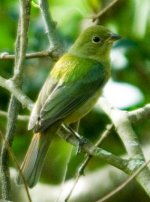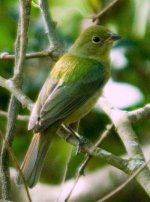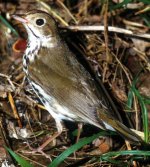-
Welcome to BirdForum, the internet's largest birding community with thousands of members from all over the world. The forums are dedicated to wild birds, birding, binoculars and equipment and all that goes with it.
Please register for an account to take part in the discussions in the forum, post your pictures in the gallery and more.
You are using an out of date browser. It may not display this or other websites correctly.
You should upgrade or use an alternative browser.
You should upgrade or use an alternative browser.
Need Help to Confirm a Bird ID (1 Viewer)
- Thread starter adubin
- Start date
More options
Who Replied?Steve Lister
Senior Birder, ex County Recorder, Garden Moths.

I was going to suggest female Scarlet Tanager until the previous post popped up. The shape of the bill rules out Pine Warbler.
Steve
Steve
Last edited:
gerdwichers8
Well-known member
An adult female Painted Bunting must be the bird; a Summer Tanager will show a long bill with grey all allong as one of the most obvious features.
Steve Lister
Senior Birder, ex County Recorder, Garden Moths.

gerdwichers8 said:An adult female Painted Bunting must be the bird; a Summer Tanager will show a long bill with grey all allong as one of the most obvious features.
I meant Scarlet, not Summer. Have changed it now. Agree that Painted Bunting is the most likely.
Steve
gerdwichers8
Well-known member
Steve Lister said:I meant Scarlet, not Summer.
Steve
Yes, you are right, the adult female Scarlet Tanager looks much more like it; I already felt the connection with that species instead of Summer.
atricapillus
Well-known member
_____________overworkedirish said:Agree with female Painted Bunting. Nice shot!
Agree on Painted Bunting, but it looks a little bright, and may be a first-year male. PABUs show delayed plumage maturation where the 1st year males look like females [or approach female plumage]. BLagopus may be able to help with all his picture-manipulation skills. From the tiny window on the primary coverts, the edgings look a little different tone then the primary edgings. If these primary coverts are actually tan, it may confirm this bird as a 1st-year male.
CHEERS, JOE G
atricapillus said:_____________
Agree on Painted Bunting, but it looks a little bright, and may be a first-year male. PABUs show delayed plumage maturation where the 1st year males look like females [or approach female plumage]. BLagopus may be able to help with all his picture-manipulation skills. From the tiny window on the primary coverts, the edgings look a little different tone then the primary edgings. If these primary coverts are actually tan, it may confirm this bird as a 1st-year male.
CHEERS, JOE G
Hadn't even crossed my mind, Joe - thanks! I don't have any materials to reference on the matter of 1st-year passerines, but perhaps someone does.
P.S. Side-note - some may have noted the "female" Lazuli Bunting in Connecticut that was (may still be) here for a while - it was such a bright bird that some people are posing the same question you just did, Joe! Photos of it here:
http://ctbirding.org/images_rare/07/07laz792NP.jpg
http://www.flickr.com/photos/born2hang/tags/lazuli/
JANJ
Well-known member
When is it taken?
Apparently western and eastern Painted has a different moult cycle, eastern bird moult on the breeding grounds while western birds moult on stopovers and winter grounds. I´m having difficulties to see if the primary coverts are brownish (both sexes in SY) There seems to be no red or blue feathers (depending when it´s take) in it´s plumage. If the primary coverts (refering only to those now) turns out to be brownish it would as mentioned indicate both a female or male SY. Looking at the freshness of the plumage and tail (if we now consider it to be taken recently) the late moult of a western bird would be proper for such a fresh looking bird, but since western birds winters in Mexico and C. America it´s probably an eastern bird. The image is in need of some manipulation I think.
http://elibrary.unm.edu/sora/JFO/v063n04/p0445-p0454.pdf
JanJ
Apparently western and eastern Painted has a different moult cycle, eastern bird moult on the breeding grounds while western birds moult on stopovers and winter grounds. I´m having difficulties to see if the primary coverts are brownish (both sexes in SY) There seems to be no red or blue feathers (depending when it´s take) in it´s plumage. If the primary coverts (refering only to those now) turns out to be brownish it would as mentioned indicate both a female or male SY. Looking at the freshness of the plumage and tail (if we now consider it to be taken recently) the late moult of a western bird would be proper for such a fresh looking bird, but since western birds winters in Mexico and C. America it´s probably an eastern bird. The image is in need of some manipulation I think.
http://elibrary.unm.edu/sora/JFO/v063n04/p0445-p0454.pdf
JanJ
B Lagopus
Voler
atricapillus said:_____________
Agree on Painted Bunting, but it looks a little bright, and may be a first-year male. PABUs show delayed plumage maturation where the 1st year males look like females [or approach female plumage]. BLagopus may be able to help with all his picture-manipulation skills. From the tiny window on the primary coverts, the edgings look a little different tone then the primary edgings. If these primary coverts are actually tan, it may confirm this bird as a 1st-year male.
CHEERS, JOE G
Hello everyone, there are some issues with this photo, but of the sort that need to be approached carefully. The photo is suffused with green, both shifted into the green and close to 10% of the pixels being "blown out" at maximum saturation. This is shown by the green in all white areas that are not themselves blown out, among other things.
I slightly backed off both the green in a color channel mix layer, and then overall saturation in another layer, to get to the slightly modified image below. The image is intended to be conservative, in that I did not entirely remove the green suffusion, preferring to err on the cautious side.
Yes, there is a bit of reddish tint in the primary coverts that could be called tannish, but it is weak to be drawing any definitive conclusions from. Perhaps more interesting is the extent of the red in the edging for the rectrices, the reddish in the rump and vent, and the touch of blue on the wing coverts (which Sibley subtly illustrates in his first year male). These are all visible even in the original intensely green saturated photo, they just become plainer when I dull things down just a tad.
I don't know enough to be drawing any conclusions of my own, but I do think that Joe just may be on to something!
Hope this helps!
Attachments
atricapillus
Well-known member
____________________________B Lagopus said:Hello everyone, there are some issues with this photo, but of the sort that need to be approached carefully. The photo is suffused with green, both shifted into the green and close to 10% of the pixels being "blown out" at maximum saturation. This is shown by the green in all white areas that are not themselves blown out, among other things.
I slightly backed off both the green in a color channel mix layer, and then overall saturation in another layer, to get to the slightly modified image below. The image is intended to be conservative, in that I did not entirely remove the green suffusion, preferring to err on the cautious side.
Yes, there is a bit of reddish tint in the primary coverts that could be called tannish, but it is weak to be drawing any definitive conclusions from. Perhaps more interesting is the extent of the red in the edging for the rectrices, the reddish in the rump and vent, and the touch of blue on the wing coverts (which Sibley subtly illustrates in his first year male). These are all visible even in the original intensely green saturated photo, they just become plainer when I dull things down just a tad.
I don't know enough to be drawing any conclusions of my own, but I do think that Joe just may be on to something!
Hope this helps!
Some of the sex analysis of this bird depends on when the photo was taken. If it was recent (early March), it can be in alternate plumage already, possibly its first alternate. Thompson indicates that molt into alternate occurs between Dec and May.
Thompson also indicates that males and females are very similar in this plumage, but also indicates that 40% of these second summer males have some blue feathers in the head. So 60% of them are entirely green like females, and the other 40% are green except for a few head feathers.
One of the things that happens in many emberizine passerines is that post-juvenile molt is incomplete, one of the features retained being the juvenile primary coverts. They dull and brown or tan such that they appear different in tone than the greater coverts. Usually they will be be browny and have tan feather edgings different then edgings of the greater coverts. As Janj indicates, this will occur in both males and females.
In looking at BLagopus' somewhat enhanced photos, the primary coverts do appear of different tone and tanner, with tanner edgings, suggesting a bird born the previous summer. If the picture was taken in March, it would be coded as an SY by NA bird banders, meaning in its second calender year of life.
[I have attached a photo of an SY Ovenbird. Note the tan primary coverts and alula--also how pointed the alula is on this bird. You would think typical adult otherwise.]
The bunting appears to be a fairly bright green, particularly in the shoulder. This is what is suggesting male to me. Females may brighten with age, but if the tones of the primary coverts is accurately depicted, then it is likely an SY bird, and a bright one. Thus, the suggestion that it is an SY male Painted Bunting rather than a female.
I have seen these green males singing in Oklahoma routinely, and have captured family groups with bright green males, green females and dull green juveniles. I can't assess how the tail should be for eastern SY Painted Buntings, so can only offer this male hypothesis as a possibility, although given the dull tan tone of the primary coverts, and brightness of the green in other body plumage areas, may be a strong possibility.
CHEERS, JOE G
Attachments
Last edited:
Users who are viewing this thread
Total: 2 (members: 0, guests: 2)






